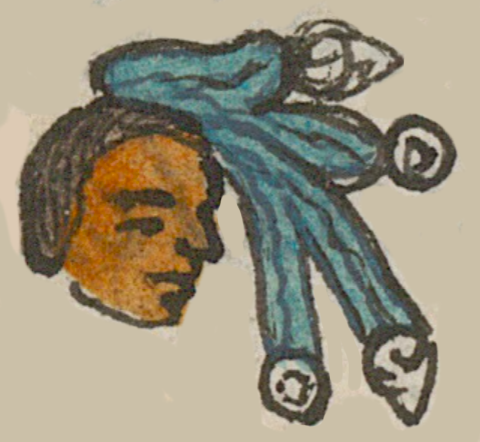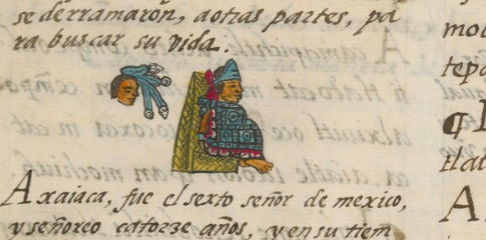Axayacatl (FCbk8f2r)
This painted compound glyph stands for the personal name Axayacatl. It consists of four short streams of water (atl) flowering over a face (xayacatl). The face is that of a male, with terracotta-color skin and brown hair. He is simply a head, shown in profile, facing to the viewer's right. We know that he is male because of his haircut (with bangs and the rest just below the ears). Also, the context image shows that Axayacatl is wearing the men's cape and his sitting posture has his knees up under his chin.
The water starts flowing at the top of the man's forehead and streams down his face. Two droplets/beads (white) and two turbinate shells (also white) come off the water, and the water is painted a turquoise blue. Black lines of current suggest movement.
Stephanie Wood
Some have translated this name as “Water Face,” but axayacatl is also the name of an insect, the water boatman. If the latter is meant, then this glyph is fully phonographic. Axayacatl (or Axayacatzin, with the reverential suffix -tzin) was a late fifteenth-century ruler of Mexico-Tenochtitlan who expanded the empire considerably. His father was Huehue Tezozomoctli. He bore two sons, Moteuczoma Xocoyotl and Macuilmalinaltzin.] See the Codex Chimalpahin: Society and Politics in Mexico Tenochtitlan, Tlatelolco, Culhuacan, and Other Nahuatl Altepetl in Central Mexico; The Nahuatl and Spanish Annals and Accounts Collected and Recorded by don Domingo de San Antón Muñón Chimalpahin Quauhtlehuanitzin, eds. and transl. Arthur J. O. Anderson and Susan Schroeder (Norman: University of Oklahoma Press, 1997), vol. 2, 96–97.]
Stephanie Wood
Axaiaca
Axayacatl
Stephanie Wood
1577
Jeff Haskett-Wood
insecto, insectos, agua, cara, caras, emperador, emperadores, emperador, emperadores, tlatoani, tlahtoani, tlatoque, tlahtohqueh, nombres famosos, nombres de hombres

a(tl), water, https://nahuatl.wired-humanities.org/content/atl
xayaca(tl), face, https://nahuatl.wired-humanities.org/content/xayacatl
cierto insecto acuático (nombre de un emperador)
Stephanie Wood
Available at Digital Florentine Codex/Códice Florentino Digital, edited by Kim N. Richter and Alicia Maria Houtrouw, "Book 8: Kings and Lords", fol. 2r, Getty Research Institute, 2023. https://florentinecodex.getty.edu/en/book/8/folio/1v/images/0 . Accessed 20 June 2025.
Images of the digitized Florentine Codex are made available under the following Creative Commons license: CC BY-NC-ND (Attribution-NonCommercial-NoDerivs 4.0 International). For print-publication quality photos, please contact the Biblioteca Medicea Laurenziana ([email protected]). The Library of Congress has also published this manuscript, using the images of the World Digital Library copy. “The Library of Congress is unaware of any copyright or other restrictions in the World Digital Library Collection. Absent any such restrictions, these materials are free to use and reuse.”







